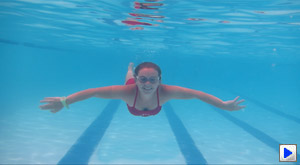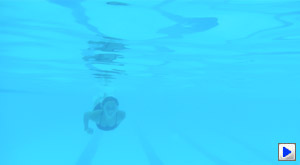Waterproof Shootout 2012: Underwater and Terrestrial
Six waterproof digital cameras comparedUnderwater Experience
Unfortunately we weren't able to test these waterproof cameras at the Cayman Wall or the reef at Bora Bora, no matter how often I insisted it was necessary. Instead, I settled for shooting at my swim club at Woodloch Springs, an upscale resort near my home and studio in the Pocono Mountains, and the editorial team also shot a few more test shots in Georgia. But Woodloch's oversized outside pool is typical of what many vacationers will experience: lots of direct overhead sunlight, clear placid water, a maximum depth of six feet and a smiling swimmer to photograph.
For reviewing the cameras' underwater aptitude, we activated each camera's primary (or only) underwater mode. We also set ISO and Flash to Auto. For underwater video, we simply pointed each camera at the model, and hoped for the best.
Maintaining negative buoyancy was a major problem, so I crouched underwater against the far edge of the pool while Sally, my wife, actually pushed her feet down on my shoulders. I had considerable difficulty viewing and framing in every camera's LCD viewfinder (as I mentioned earlier, all underwater cameras definitely should have an external frame or an oversized optical viewfinder, or both), regardless of whether I simply opened my unprotected eyes, wore neoprene goggles or used my scuba mask. The only way around this problem was to take lots of pictures of our models and hope for the best.
Underwater Video Performance
Because each camera features Full HD video recording and some sort of HDMI interface, you would think that good video and audio capture would be a given. But as with image quality, how well or poorly they do depends upon how each camera decides how to measure and respond to ambient light; how quickly each focuses and where the correct focus point is; and how smoothly the camera zooms, whether slow or rapid and jerky. Incidentally, because of how difficult it is to see or frame what you're shooting underwater, we recommend leaving the camera at wide angle and forgetting about zooming. That way, you'll cut off fewer arms and legs, as well as capture more light.
Terrestrial Image Quality
Below we've assembled a few of our "dry land" shots taken to see whether these underwater cameras might also serve as everyday carry cameras, thus saving a little money.
Without exception, all our images tended to be soft and processed, rather than razor sharp. That may be due in part to the cameras' lenses, which are optical compromises, so they can work both underwater and above water. Some of it is also excessive noise suppression, which tends to mush detail into a more artificial, watercolor appearance.
Another common problem we encountered, which led to uneven exposure and inconsistent flash, is how each cameras' built-in exposure meter reads and interprets light. At default, each camera utilizes what is called matrix or evaluative metering, which measures light in multiple areas or zones, to set the camera's shutter speed, f-stop, and whether or not to fire the auto flash. Despite being more sophisticated than simple center-weighted averaging, Matrix metering doesn't always work well, but it's the setting that 95% of camera owners use 95% of the time. Each of our cameras read ambient light differently, and selected its settings accordingly. As you'll see, some did better than others:
Wide and Telephoto Landscapes
Canon D20Daylight lakeside shots were about right considering the high dynamic range subject, though the zoomed shot is a lighter than it should be. Overall quality is Good. Visit the Canon D20 Gallery page for additional images. |
|
Nikon AW100Our train shots exhibited solid exposure and contrast, with very good dynamic range; however, nothing was terribly sharp or crisp. Our lakeside shots were impossible because the camera stopped working when its seal failed in the pool. For the shots we captured, though, we rate the Nikon's image quality as Good. Visit the Nikon AW100 Gallery page for additional images. |
|
Olympus TG-1Wide and tele lakeside shots had decent contrast and good exposure, though they weren't terribly vibrant. While not notably sharp or crisp, the images were more detailed than most others we tested in the shootout. We also liked that the telephoto image was properly exposed for the light levels. We rate the Olympus' image quality at wide and telephoto Good to Very Good. Visit the Olympus TG-1 Gallery page for additional images. |
|
Panasonic TS4Lakeside shots were fairly good, but not perfect, washing out at telephoto. We rate the Panasonic's image quality as Fair to Good. Visit the Panasonic TS4 Gallery page for additional images. |
|
Pentax WG2Lakeside shots look good, perhaps a bit dark in the wide angle shot, but with good color in the trees. We rate the Pentax's landscape images Good. Visit the Pentax WG2 Gallery page for additional images. |
|
Sony TX20Exposure was inconsistent at times, and contrast a little high. Well-exposed shots also exhibited good contrast, detail and color. Lakeside shots were again a bit washed out at telephoto. Overall, we rate the Sony's image quality as Good. Visit the Sony TX20 Gallery page for additional images. |
|
Portraits
|
Canon D20
f/4.5, 1/500, ISO 100 |
Nikon AW100
f/4.4 1/1000, ISO 125 |
Olympus TG1
f/5, 1/250, ISO 100 |
|
Panasonic TS4
f/5.4, 1/320, ISO 100 |
Pentax WG2
f/5.8, 1/400, ISO 125 |
Sony TX20
f/5, 1/500, ISO 125 |
|
Only the Sony TX20 had the good sense to turn on the fill flash for these portraits, producing a very nice image (see YDSC00005.JPG), but we forced it off to make the comparison even. The Canon D20 probably does the best overall with skintones and exposure, while the Olympus TG1 is blown out and the rest are surprisingly underexposed. We judge the Canon as Very Good, the Pentax WG2 as Good, and the others as Fair. |
||



Follow Imaging Resource: